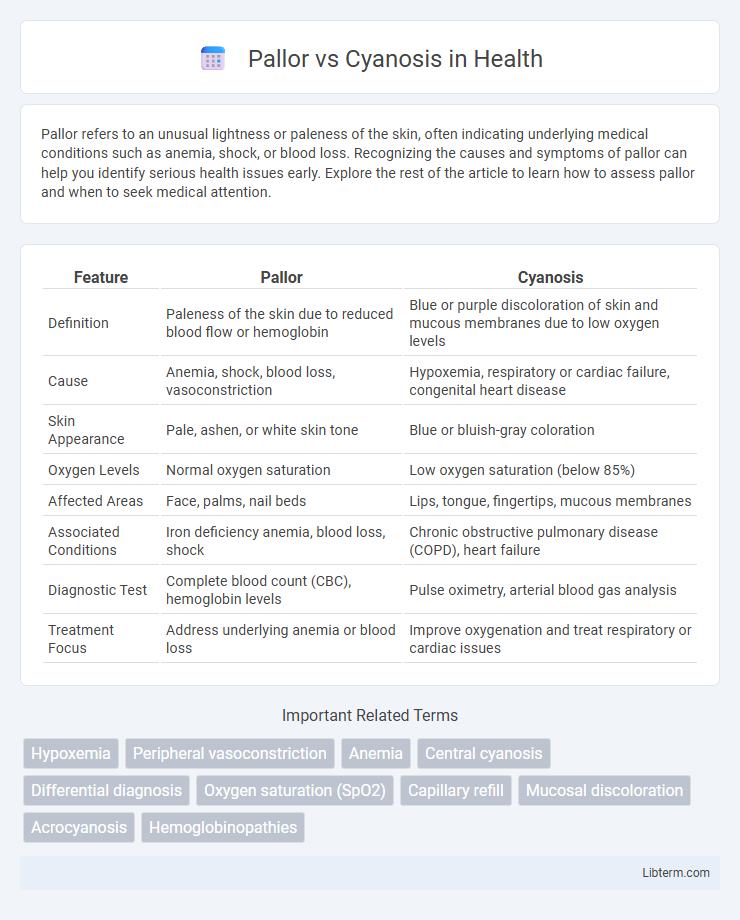Pallor refers to an unusual lightness or paleness of the skin, often indicating underlying medical conditions such as anemia, shock, or blood loss. Recognizing the causes and symptoms of pallor can help you identify serious health issues early. Explore the rest of the article to learn how to assess pallor and when to seek medical attention.
Table of Comparison
| Feature | Pallor | Cyanosis |
|---|---|---|
| Definition | Paleness of the skin due to reduced blood flow or hemoglobin | Blue or purple discoloration of skin and mucous membranes due to low oxygen levels |
| Cause | Anemia, shock, blood loss, vasoconstriction | Hypoxemia, respiratory or cardiac failure, congenital heart disease |
| Skin Appearance | Pale, ashen, or white skin tone | Blue or bluish-gray coloration |
| Oxygen Levels | Normal oxygen saturation | Low oxygen saturation (below 85%) |
| Affected Areas | Face, palms, nail beds | Lips, tongue, fingertips, mucous membranes |
| Associated Conditions | Iron deficiency anemia, blood loss, shock | Chronic obstructive pulmonary disease (COPD), heart failure |
| Diagnostic Test | Complete blood count (CBC), hemoglobin levels | Pulse oximetry, arterial blood gas analysis |
| Treatment Focus | Address underlying anemia or blood loss | Improve oxygenation and treat respiratory or cardiac issues |
Understanding Pallor and Cyanosis
Pallor is characterized by an abnormal lightness of the skin caused by reduced blood flow or decreased hemoglobin concentration, often indicating anemia or shock. Cyanosis presents as a bluish discoloration due to increased deoxygenated hemoglobin in the blood, commonly associated with respiratory or cardiovascular disorders. Differentiating pallor and cyanosis involves assessing skin tone changes, underlying oxygen saturation, and circulation status.
Key Differences Between Pallor and Cyanosis
Pallor is characterized by an abnormal lightness of the skin often caused by reduced blood flow or decreased red blood cell count, whereas cyanosis presents as a bluish discoloration due to low oxygen levels in the blood. Pallor mainly indicates anemia or blood loss, while cyanosis signals hypoxemia or impaired oxygenation in conditions like respiratory or cardiac disorders. Diagnostic evaluation of pallor involves hemoglobin levels, whereas cyanosis assessment requires pulse oximetry and arterial blood gas analysis.
Causes of Pallor
Pallor primarily results from reduced blood flow or decreased red blood cell count, caused by anemia, shock, or peripheral vasoconstriction. Conditions like iron deficiency anemia, acute blood loss, and heart failure can significantly contribute to the onset of pallor. Unlike cyanosis, which indicates increased deoxygenated hemoglobin, pallor reflects diminished hemoglobin concentration or compromised skin blood perfusion.
Causes of Cyanosis
Cyanosis results from inadequate oxygenation of blood, often caused by respiratory diseases like chronic obstructive pulmonary disease (COPD), pneumonia, or pulmonary embolism, and cardiac conditions such as congenital heart defects or heart failure. Other causes include exposure to cold, methemoglobinemia, and certain medications affecting hemoglobin function. Differentiating cyanosis from pallor is essential, as pallor stems from reduced blood flow or decreased red blood cell count rather than oxygen desaturation.
Clinical Presentation of Pallor
Pallor presents clinically as an abnormal lightness of the skin, often most noticeable in the face, conjunctiva, and nail beds, indicating decreased hemoglobin or reduced blood flow. It may result from anemia, shock, or arterial insufficiency, with patients frequently reporting fatigue or dizziness due to diminished oxygen delivery. Physical examination highlights a pale complexion without bluish discoloration, differentiating it clearly from cyanosis.
Clinical Presentation of Cyanosis
Cyanosis presents clinically as a bluish discoloration of the skin, lips, and mucous membranes, indicating significant deoxygenation of hemoglobin in capillary blood. Central cyanosis affects the tongue and oral mucosa, while peripheral cyanosis is limited to extremities and may worsen with cold exposure. Key signs include a reduction in oxygen saturation below 85% and symptoms such as shortness of breath, often associated with cardiopulmonary conditions like congenital heart disease or chronic obstructive pulmonary disease (COPD).
Diagnostic Approach: Pallor vs Cyanosis
Pallor presents as an abnormal lightness of the skin or mucous membranes, often due to reduced blood flow or decreased hemoglobin, requiring evaluation of hemoglobin levels and peripheral perfusion. Cyanosis is characterized by a bluish discoloration of the skin or mucous membranes caused by increased deoxygenated hemoglobin concentration, diagnosed through pulse oximetry, arterial blood gases, and cardiopulmonary assessment. Differentiating between pallor and cyanosis involves analyzing clinical signs alongside laboratory tests such as complete blood count and oxygen saturation measurements.
Management Strategies for Pallor
Management strategies for pallor primarily involve identifying and treating the underlying cause, such as anemia, hypovolemia, or chronic diseases. Clinical evaluation includes laboratory tests like complete blood count (CBC), iron studies, and hemoglobin levels to guide targeted therapy, which may involve iron supplementation, nutritional support, or addressing blood loss. Supportive measures include maintaining adequate hydration and oxygenation to improve tissue perfusion and patient outcomes.
Treatment Options for Cyanosis
Treatment options for cyanosis focus on addressing the underlying cause, such as oxygen therapy for hypoxemia or medications to improve cardiac function in congenital heart defects. In cases of methemoglobinemia, treatments like methylene blue can be administered to restore normal hemoglobin function. Severe cyanosis due to respiratory or cardiovascular conditions may require advanced interventions including mechanical ventilation or surgical correction.
When to Seek Medical Attention: Pallor vs Cyanosis
Seek medical attention for pallor if accompanied by symptoms such as dizziness, chest pain, or unusual fatigue, as it may indicate anemia or circulatory issues. Cyanosis requires urgent medical evaluation when blue discoloration appears on the lips, face, or extremities, signaling possible hypoxia or respiratory distress. Persistent or worsening discoloration in either condition demands prompt healthcare assessment to determine underlying causes and necessary interventions.
Pallor Infographic

 libterm.com
libterm.com